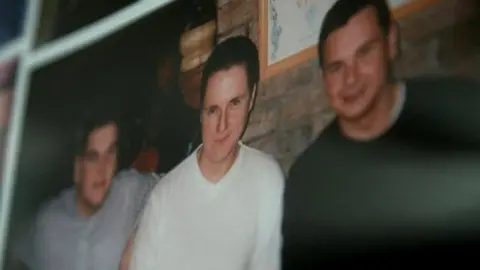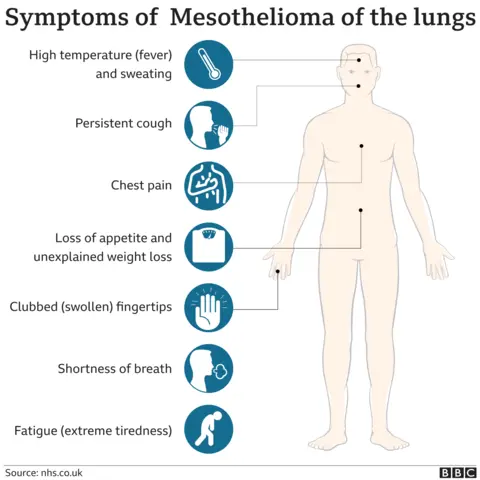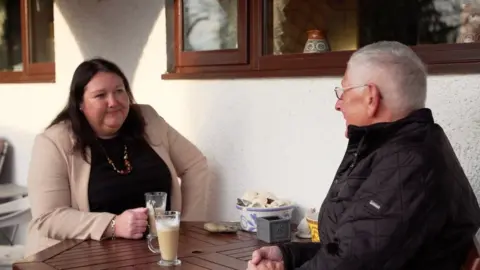Asbestos exposure from 20 years ago killed IT worker
"It's a death sentence to anybody. All it takes is one breath at the wrong time in the wrong place."
As a young man working in IT, Jason Williams had no idea his job might endanger his life.
But 20 years later, by then a father of two teenagers, he was diagnosed with mesothelioma, a form of cancer linked to asbestos exposure.
He died six months later. He was just 45 years-old.
Now his father, Roy Williams, is urging bosses in the private and public sectors to remove asbestos from buildings immediately.
"It's aggressive, very aggressive. And there is no cure, and there's no treatment. It's a death sentence," said Mr Williams.
"My primary aim is to get the asbestos out of those buildings, so that families like mine don't go through anything like this."

Jason's Story
Roy Williams, from Ammanford in Carmarthenshire, had three sons - all of whom followed in his footsteps into the IT industry.
Jason, his middle boy, "did well in school, did everything that was expected of him academically," according to his dad.
After graduating from university, Jason began his career in IT. One of his first jobs, as a graduate in his early 20s, was at the steelworks in Port Talbot - "he loved every minute of it."
However, during this time, while running cables and fitting computers, it is believed he was exposed to asbestos.
He would not know about the danger he had been exposed to for many years.

Jason went on to have a wife and two children and was eventually headhunted by a global IT firm.
"All the hard work he'd done, started to bear fruit," said Roy Williams.
It was around this time, in his mid-40s, that he became ill, spending his 45th birthday in hospital.
In March 2019 Jason was diagnosed with mesothelioma.
"They took a biopsy…. a fortnight later, he and I went in to see the consultant, and the consultant told him to his face that he'd been exposed to asbestos - mesothelioma," said Mr Williams.
"We couldn't even pronounce it. We didn't even know what it meant. And to be fair, the consultant didn't know. Because he turned to my son and he said, 'If you want to really know all about it, Google it.'"
He was given six to 12 months to live.

"It was horrible, horrific. Six months of seeing a boy… he was a handsome, strong man. And then suddenly [he] disappeared to nothing and died six months later," added Mr Williams.
"We're grateful as a family that he didn't suffer too long, because some, they go on and on.
"It was six months from beginning to end when he was diagnosed to his death, from a fit handsome young lad to suddenly… we buried him. But that's mesothelioma."
What is Mesothelioma?
About 5,000 people die each year from an asbestos-related illness, about half of those die of mesothelioma.
In 2019, there were 2,369 mesothelioma deaths in the UK. The majority of those who died were male and over 75 years old.
Mesothelioma is a type of cancer caused by someone inhaling asbestos fibres.
It takes many years to develop, but when symptoms do show, patients often die within a year of diagnosis.
About 85% of cases of Mesothelioma in men are attributable to asbestos exposure in the workplace according to the Health & Safety Executive.
What are the symptoms for Mesothelioma?

The most common form of the illness is pleural Mesothelioma, which affects the lungs.
Symptoms for this include shortness of breath, chest pain and a persistent cough.
Less commonly this illness can affect the stomach - and in rarer cases, the testicles - which is called peritoneal Mesothelioma.
Stomach pains, a swollen abdomen and constipation or diarrhoea are symptoms for this type.
People are advised to contact their GP or the support team at Mesothelioma UK, if they spot these symptoms and have concerns.
What are the rules around Asbestos?
Using asbestos as a building material has been banned since 1999.
However, many residential and commercial buildings still contain asbestos.
It is generally considered safe if it is not disturbed.
The responsibility of maintaining asbestos materials in non-domestic buildings lies with the owners.
With help from his union, Unite, Jason Williams' family took legal action against the company he worked for at the time, Cap Gemini, and the current owners of the steelworks, TATA Steel.
Legal proceedings continued after his death and his family were awarded compensation.
Amanda Jones from Thompsons Solicitors represented the family and has worked on Asbestos cases for 20 years.
Cases used to involve workers from traditional occupations in heavy industries, but she says that pattern has started to change.

"We've now in more recent years seen a trend in non-traditional [cases], with nurses, teachers, care workers. People who are working in buildings where asbestos is in situ and clearly as in Jason's case has been disturbed."
"We are sadly continuing to see men and women exposed," she added, "that must stop and we must do all we can to prevent that happening. We do not want to see more asbestos victims in the future".
In a statement, TATA Steel said that they were unable to comment on any specific cases that had been dealt with.
They said they "take asbestos issues very seriously and comply with both the law and our own Health and Safety standard ensure we reduce any risk of exposure to those working on our sites."
Cap Gemini have been asked to comment.
Roy Williams' focus is now on ensuring that asbestos is removed safely from all buildings.
"It shouldn't be [there] - not 22 years later after the bill was passed to stop them from using it. There should have been plans in place to quietly remove it or something. But there it was, and still is.
"It doesn't make sense. Please change the law and make people look at the high risk areas and get rid of it. There are 1000s dying every year."

- SURVIVING HELMAND: Inspirational stories from those deeply affected by the conflict in Afghanistan
- TIP NUMBER 7: The families of Aberfan fight for justice

